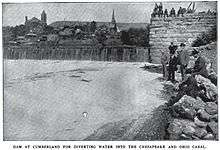Cumberland Dam
The Cumberland Dam was built across the North Branch of the Potomac River at Cumberland, Maryland, for the purpose of diverting water of the river into the head of the Chesapeake and Ohio Canal. The Chesapeake and Ohio Canal Company began construction of its Dam No. 8 in 1837 and work proceeded intermittently, finally concluding in 1850.[1]:242 The dam impounded water over a distance of a mile, causing back water for about 3 miles (4.8 km) up the river. Above the dam is the mouth of Wills Creek.

Environmental Impact
In the early 1900s Wills Creek received a large quantity of industrial sewage and refuse from a paper mill, a brewery, a distillery, a cement works, a tannery, dye works, a gas plant, and a number of coal mines. Further, in the early 1900s the city of Cumberland supplied 2,500,000 US gallons (9,500 m3) of water and discharged 1,000,000 US gallons (3,800 m3) per day into Wills Creek. As may be expected, these pollutants accumulated in the pond above the dam as if in a settling basin, especially in seasons of low water when no water passed over the crest of the dam.
About 400 yards (370 m) above the dam was the intake of the Cumberland waterworks, where the city's water was pumped from the river directly into the water mains and was served to the inhabitants without being purified through filter beds or other artificial means. Serious complaints arose from year to year prior to 1900 during the dry season, when the water, besides being unpalatable, was scarcely clean enough for laundering purposes. Of the large percentage of impurities which the water contained at such times, a portion was doubtlessly made up of sewage from the city that had backed up to the point of intake.
Much has changed since 1900 to eliminate these problems. The city's economy has made a significant transition away from manufacturing and coal production. The city's water is filtered and supplied from other water supplies. Its sewage is now treated.
References
- Unrau, Harland D. (2007) [1976]. Gray, Karen M. (ed.). Historic Resource Study: Chesapeake & Ohio Canal (PDF). Hagerstown, MD: U.S. National Park Service.
- Newell, F.H. (1900). "The Hydrography of Allegany County". Maryland Geological Survey: Allegany County. Baltimore: Johns Hopkins Press. p. 250.